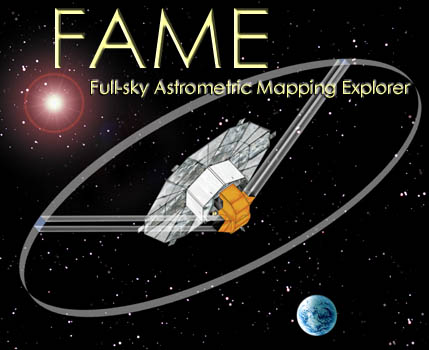Full-sky Astrometric Mapping Explorer on:
[Wikipedia]
[Google]
[Amazon]
 Full-sky Astrometric Mapping Explorer (or FAME) was a
Full-sky Astrometric Mapping Explorer (or FAME) was a
 Full-sky Astrometric Mapping Explorer (or FAME) was a
Full-sky Astrometric Mapping Explorer (or FAME) was a NASA
The National Aeronautics and Space Administration (NASA ) is an independent agencies of the United States government, independent agency of the US federal government responsible for the civil List of government space agencies, space program ...
proposed astrometric
Astrometry is a branch of astronomy that involves precise measurements of the positions and movements of stars and other celestial bodies. It provides the kinematics and physical origin of the Solar System and this galaxy, the Milky Way.
His ...
satellite designed to determine with unprecedented accuracy the positions, distances, and motions of 40 million stars within our galactic neighborhood (distances by stellar parallax possible). This database was to allow astronomers to accurately determine the distance to all of the stars on this side of the Milky Way
The Milky Way is the galaxy that includes our Solar System, with the name describing the galaxy's appearance from Earth: a hazy band of light seen in the night sky formed from stars that cannot be individually distinguished by the naked eye. ...
galaxy, detect large planets and planetary systems around stars within 1,000 light years of the Sun
The Sun is the star at the center of the Solar System. It is a nearly perfect ball of hot plasma, heated to incandescence by nuclear fusion reactions in its core. The Sun radiates this energy mainly as light, ultraviolet, and infrared radi ...
, and measure the amount of dark matter in the galaxy from its influence on stellar motions. It was to be a collaborative effort between the United States Naval Observatory
United States Naval Observatory (USNO) is a scientific and military facility that produces geopositioning, navigation and timekeeping data for the United States Navy and the United States Department of Defense. Established in 1830 as the Depo ...
(USNO) and several other institutions. FAME would have measured stellar positions to less than 50 microarcseconds. The NASA MIDEX mission was scheduled for launch in 2004. In January 2002, however, NASA abruptly cancelled this mission, mainly due to concerns about costs, which had grown from US$160 million initially to US$220 million.
This would have been an improvement over the High Precision Parallax Collecting Satellite ( Hipparcos) which operated 1989-1993 and produced various star catalogs. Astrometric parallax measurements form part of the cosmic distance ladder
The cosmic distance ladder (also known as the extragalactic distance scale) is the succession of methods by which astronomers determine the distances to celestial objects. A ''direct'' distance measurement of an astronomical object is possible o ...
, and can also be measured by other space telescope
A space telescope or space observatory is a telescope in outer space used to observe astronomical objects. Suggested by Lyman Spitzer in 1946, the first operational telescopes were the American Orbiting Astronomical Observatory, OAO-2 launch ...
s such as Hubble (HST) or ground-based telescopes to varying degrees of precision.
Compared to the FAME accuracy of 50 microarcseconds, the Gaia mission
''Gaia'' is a space observatory of the European Space Agency (ESA), launched in 2013 and expected to operate until 2025. The spacecraft is designed for astrometry: measuring the positions, distances and motions of stars with unprecedented preci ...
is planning 10 microarcseconds accuracy, for mapping stellar parallax up to a distance of tens of thousands of light-years from Earth.
See also
*Explorer program
The Explorers program is a NASA exploration program that provides flight opportunities for physics, geophysics, heliophysics, and astrophysics investigations from space. Launched in 1958, Explorer 1 was the first spacecraft of the United Stat ...
* Gaia (spacecraft)
''Gaia'' is a space observatory of the European Space Agency (ESA), launched in 2013 and expected to operate until 2025. The spacecraft is designed for astrometry: measuring the positions, distances and motions of stars with unprecedented preci ...
* Nano-JASMINE
References
{{Space observatories Explorers Program Space telescopes Space astrometry missions